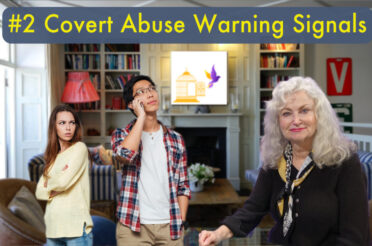Overview
According to the CDC, from 2003 through 2014, homicide was the leading cause of death for women under the age of 44. However, within the same group, 55% of all women’s homicides were attributed to intimate partner violence. In other words, when it comes to the murder of women, the most significant risk comes from your married or unmarried intimate partner.
However, those numbers are just the tip of the iceberg. While the CDC measures the statistics on violence against women, a deeper but hidden level of psychological control occurs. A movement has been growing aimed at identifying covert abuse by one partner to manipulate and restrict the activities of the other partner.
Covert abuse is not generally part of our public conversations, not in the media or entertainment. Women are particularly vulnerable, and while a percentage of men are subject to this type of abuse, women are far more likely to experience deep psychological trauma due to enduring years of systematic manipulation and coercion.
Our interview is with Ruth Darlene, Founder and Executive Director of WomenSV, known as Women of Silicon Valley.
Ruth explains how covert abuse starts, defines the early signs, discusses the techniques the covert abuser employs, provides strategies to validate the level of abuse, and provides specific actions to take in breaking the dynamics of dealing with an abusive intimate partner.
The topics addressed in this interview are:
- 00:00 Intro to coercive control with Ruth Darlene
- 02:38 Definition of coercive control
- 03:50 Domestic Violence vs coercive control
- 05:04 The behavior of the covert abuser
- 06:12 the three steps in coercive control
- 07:19 Community support for Law Enforcement
- 08:47 The isolation of friends and family
- 10:12 How to recognize the pattern in coercive control
- 11:30 The litmus test to define coercive control
- 13:37 How to take action
- 15:11 Planning the exit from the relationship
- 16:18 The revenge phase
- 17:23 CA Family Code 6320
- 18:15 Case study of a woman who stopped the abuse
- 20:20 Follow up information about WomenSV.org
- 21:20 Final comments
CA Family Law 6320
(a) The court may issue an ex parte order enjoining a party from molesting, attacking, striking, stalking, threatening, sexually assaulting, battering, credibly impersonating as described in Section 528.5 of the Penal Code, falsely personating as described in Section 529 of the Penal Code, harassing, telephoning, including, but not limited to, making annoying telephone calls as described in Section 653m of the Penal Code, destroying personal property, contacting, either directly or indirectly, by mail or otherwise, coming within a specified distance of, or disturbing the peace of the other party, and, in the discretion of the court, on a showing of good cause, of other named family or household members.(b) On a showing of good cause, the court may include in a protective order a grant to the petitioner of the exclusive care, possession, or control of any animal owned, possessed, leased, kept, or held by either the petitioner or the respondent or a minor child residing in the residence or household of either the petitioner or the respondent. The court may order the respondent to stay away from the animal and forbid the respondent from taking, transferring, encumbering, concealing, molesting, attacking, striking, threatening, harming, or otherwise disposing of the animal.
(c) As used in this subdivision (a), “disturbing the peace of the other party” refers to conduct that, based on the totality of the circumstances, destroys the mental or emotional calm of the other party. This conduct may be committed directly or indirectly, including through the use of a third party, and by any method or through any means including, but not limited to, telephone, online accounts, text messages, internet-connected devices, or other electronic technologies. This conduct includes, but is not limited to, coercive control, which is a pattern of behavior that in purpose or effect unreasonably interferes with a person’s free will and personal liberty. Examples of coercive control include, but are not limited to, unreasonably engaging in any of the following:
(1) Isolating the other party from friends, relatives, or other sources of support.
(2) Depriving the other party of basic necessities.
(3) Controlling, regulating, or monitoring the other party’s movements, communications, daily behavior, finances, economic resources, or access to services.
(4) Compelling the other party by force, threat of force, or intimidation, including threats based on actual or suspected immigration status, to engage in conduct from which the other party has a right to abstain or to abstain from conduct in which the other party has a right to engage.
(5) Engaging in reproductive coercion, which consists of control over the reproductive autonomy of another through force, threat of force, or intimidation, and may include, but is not limited to, unreasonably pressuring the other party to become pregnant, deliberately interfering with contraception use or access to reproductive health information, or using coercive tactics to control, or attempt to control, pregnancy outcomes.
(d) This section does not limit any remedies available under this act or any other provision of law.
(Amended by Stats. 2021, Ch. 135, Sec. 1. (SB 374) Effective January 1, 2022.)







